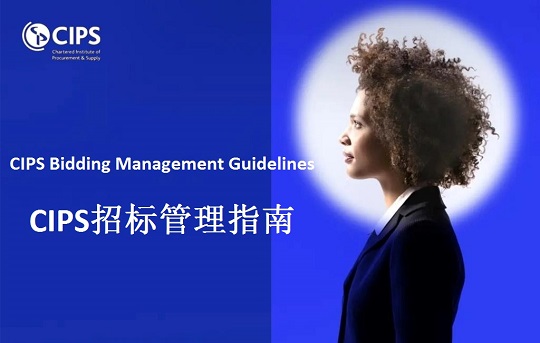- 【学习贴】CIPS招标管理指南
- 发布时间:2023-08-15 13:45:57 阅读次数:214
CIPS Bidding Management Guidelines
CIPS招标管理指南

This CIPS practice document is written as a statement in time. It is a collection of views on good practice within a particular subject area. This document will provide you with an understanding of tendering and post tender negotiation and will explore the following -
这份CIPS实践文档是及时写成的。它是关于特定主题领域内良好实践的观点的集合。本文件将帮助您了解招标和招标后谈判,并将探讨以下内容
ü pre-requisites for tendering
投标的先决条件
ü Documentation
文档
ü pre-qualification
资格预审
ü dialogue with suppliers
与供应商对话
ü response time for tenders
投标响应时间
ü tender boards/evaluation panels
招标委员会/评估小组
ü selection criteria
选择标准
ü post tender negotiation
招标后谈判
ü contract award
合同授予
Definition
定义
Tendering can be defined as ‘the process used by a procurement professional to decide from a number of bidders which one should be awarded the contract,Post tender negotiation can be defined as ‘negotiation that occurs after the best value supplier has been chosen. This is to see if any further improvements can be made before the contract is awarded’. (CIPS, 2021)
招标可以定义为“采购专业人员从众多投标人中决定应授予合同的过程”。 招标后谈判可以定义为“选择最佳价值供应商后进行的谈判”。这是为了看看在授予合同之前是否可以做出进一步的改进。” (CIPS,2021 年)
Background
背景
There are a variety of means of obtaining offers from suppliers such as ‘requests for proposal/quotation/information’ (RFP/RFQ/RFI), ‘enquiries’ etc. many of which can be confused to mean the same process. CIPS believes that obtaining an offer from a supplier has a range of different degrees of complexity, and that tendering is most appropriate for high value and high-risk purchases where transparency is paramount.
从供应商处获取报价的方式有多种,例如“征求建议书/报价/信息”(RFP/RFQ/RFI)、“询价”等。其中许多方式可能会被混淆为同一过程。CIPS 认为,从供应商处获取报价具有一系列不同程度的复杂性,招标最适合透明度至关重要的高价值和高风险采购。
As core elements in procurement and supply management, CIPS considers that all professional procurement and supply managers (P&SM) should be proficient in the application of tendering and post tender negotiation.
作为采购和供应管理的核心要素,CIPS认为所有专业的采购和供应经理(P&SM)都应该精通招标和标后谈判的应用。
Explanation
解释
The advantages of tendering include:
招标的优点包括:
ü transparency
透明度
ü an established, accepted and generally understood process
已建立的、接受的和普遍理解的过程
ü an audit trail
审计追踪
ü compliance with the organisation's policy
遵守组织的政策
ü fairness to all parties
对各方公平
ü the encouragement of competition
鼓励竞争
ü the production of a written quotation, along with relevant supporting information, against a prescribed need
根据规定的需要制作书面报价以及相关支持信息
ü an easier comparison of offers
更轻松地比较报价
The weaknesses of tendering include:
招标的缺点包括:
ü it can be very bureaucratic
这可能非常官僚
ü it may provide a barrier for SMEs
它可能为中小企业提供障碍
ü it can be a triumph of process over substance
这可能是过程战胜实质的胜利
ü it can inhibit flair, creativity and innovation
它会抑制天赋、创造力和创新
ü it can be expensive for all parties e.g. the time and resource in preparation and evaluation of tenders
对于所有各方来说,例如准备和评估标书的时间和资源都可能很昂贵
ü it can inhibit negotiation
它会抑制谈判
ü prices submitted are often inflated to allow room for negotiation
提交的价格经常被夸大,以留出议价空间
Pre-requisites for tendering
投标的先决条件
CIPS believes that a good specification is an important factor in achieving value for money. It is vital when inviting tenders, the greater the financial commitment the more important a clear specification is, P&SM professionals should ensure the existence of an appropriate specification.
CIPS 认为,良好的规格是实现物有所值的重要因素。招标时至关重要,财务承诺越大,明确的规格就越重要,P&SM 专业人员应确保存在适当的规格。
Generally, specifications for complex requirements should be output or outcome-based i.e., what is to be achieved as opposed to how it should be achieved, or functional i.e., what the requirement should be able to do as opposed to its technical profile. Such specifications enable suppliers to be innovative in their solutions. In some cases, technical specifications are useful and needed, especially in manufacturing and/or engineering scenarios. The P&SM professional must ensure the drafter of the specification is absolutely clear about the requirement and that they are capable of specifying it properly.
一般来说,复杂需求的规范应该是基于输出或结果的,即要实现什么而不是如何实现,或者是功能性的,即需求应该能够做什么而不是其技术概况。这些规范使供应商能够在解决方案中进行创新。在某些情况下,技术规范是有用且需要的,特别是在制造和/或工程场景中。P&SM 专业人员必须确保规范的起草者绝对清楚要求,并且他们有能力正确地指定它。
Such specifications should be described in terms of commonly used standards, e.g., European standards, British standards, International standards (ISO). When using a technical standard, care must be taken to avoid proprietary items, where possible. When using a choice of standards, those standards must be comparable.
此类规范应按照常用标准来描述,例如欧洲标准、英国标准、国际标准(ISO)。使用技术标准时,必须注意尽可能避免专有项目。当使用选择的标准时,这些标准必须具有可比性。
Documentation
文档
There are various elements that CIPS suggests could comprise an invitation to tender (ITT) document such as:
CIPS 建议招标邀请 (ITT) 文件可包含多种要素,例如:
ü A covering letter providing instructions e.g., labels to be used, return date, contact names and numbers etc. with some background to the requirement and also a statement that reads along the lines of "we are not bound to accept any, or the lowest tender".
一封附信,提供说明,例如要使用的标签、返回日期、联系人姓名和电话号码等,并附有一些要求背景,以及一份声明,内容大致如下:“我们没有义务接受任何或最低的投标”。
ü An acknowledgement form - to be returned stating whether or not the supplier is intending to submit a tender.
确认表 - 需返回,说明供应商是否打算提交投标。
ü A specification (as above).
规范(如上所述)。
ü A cost, price and delivery schedule - to be completed with the price and corresponding costs components e.g., information to assist whole life costing along with the expected delivery or lead time.
成本、价格和交货计划 - 填写价格和相应的成本组成部分,例如协助整个生命周期成本计算的信息以及预期交货或交货时间。
ü A detailed breakdown of production costs e.g., margin, overheads etc. to be completed.
需要完成生产成本的详细细目,例如利润、管理费用等。
ü A quality schedule - declaring which quality standards are met by the supplier.
质量计划 - 声明供应商满足哪些质量标准。
ü A signed declaration of bona fide tender.
签署的善意投标声明。
ü A parent company guarantee/performance bond to be completed as appropriate.
酌情填写母公司担保/履约保证金。
ü A series of questions on policy e.g., health and safety, environment, social responsibility etc. to which the supplier should respond.
供应商应回应的一系列政策问题,例如健康和安全、环境、社会责任等。
ü A list of information required on the supplier's company profile (if not already obtained).
供应商公司简介所需的信息列表(如果尚未获取)。
ü A request for the supplier's company accounts e.g., for the last three years (if not already obtained).
要求提供供应商的公司账户,例如过去三年的账户(如果尚未获得)。
ü A list of satisfied customers along with at least one reference.
一份满意客户名单以及至少一份参考资料。
Pre-qualification
资格预审
CIPS advocates the use of pre-qualification before inviting tenders wherever possible. This is so that suppliers which are unsuitable for the requirement in question can be eliminated from the tendering process. For example, pre-qualification would include an evaluation of suppliers':
CIPS 提倡尽可能在招标前进行资格预审。这样可以将不适合相关要求的供应商从招标过程中剔除。例如,资格预审将包括对供应商的评估:
ü financial standing
财务状况
ü quality procedures
质量程序
ü capacity and competence
能力和能力
ü track record
跟踪记录
These criteria would then not be required in the ITT and can be used in any subsequent tendering exercises. However, depending on the market, it is recommended that pre-qualified suppliers are evaluated in this way periodically.
ITT 中不再需要这些标准,并且可以在任何后续招标活动中使用。然而,根据市场情况,建议定期对通过资格预审的供应商进行评估。
If a pre-qualified list of tenderers is to be used (so that the suppliers are all known in advance as opposed to simply responding to an advertisement) it is acceptable practice to advise these suppliers that an ITT for the supplies or services in question will be forwarded to them by a specific date. This enables suppliers to plan for what can be a resource intensive process.
如果要使用资格预审的投标人名单(以便提前了解所有供应商,而不是简单地回复广告),则可以接受的做法是告知这些供应商,相关供应品或服务的 ITT 将在在特定日期之前转发给他们。这使得供应商能够规划资源密集型流程。
CIPS believes that suppliers should not be requested to pay for ITT documentation as this discriminates against small to medium sized enterprises.
CIPS 认为,不应要求供应商支付 ITT 文件费用,因为这对中小型企业构成歧视。
Dialogue with suppliers
与供应商对话
To refine and finalise the requirement, CIPS believes it is acceptable practice to discuss requirements with suppliers before tenders are invited. This will allow the contractee to supplement his knowledge of the requirement and to discover possible avenues of innovation for the future. However, suppliers must be advised that this is the purpose of the dialogue and care must be taken not to include any proprietary information within the specification that is developed as a result of these discussions.
为了完善和最终确定该要求,CIPS 认为在招标之前与供应商讨论要求是可以接受的做法。这将使签约方能够补充其对需求的了解,并发现未来可能的创新途径。然而,必须告知供应商,这是对话的目的,并且必须注意不要在这些讨论所制定的规范中包含任何专有信息。
Variations may arise during the tendering process and P&SM professionals should ensure that all suppliers receive exactly the same information and, as far as possible, at the same time.
招标过程中可能会出现变化,P&SM 专业人员应确保所有供应商尽可能在同一时间收到完全相同的信息。
Response times for tenders
投标响应时间
In respect of the utilities and public sectors in Europe contracts above a published threshold are subject to the Public Procurement act - https://ec.europa.eu/info/index_en. For those contracts that are not governed by legislative requirements it is still the responsibility of the buying organisation to set reasonable time periods for responses to tenders.
对于欧洲的公用事业和公共部门,超过公布阈值的合同须遵守公共采购法 - https://ec.europa.eu/info/index_en。对于那些不受立法要求约束的合同,采购组织仍然有责任设定合理的响应投标的时间段。
CIPS believes that it should be the responsibility of P&SM professionals to determine a reasonable period for responses. This will depend on variables such as the complexity of the items being procured, the nature of the marketplace and the urgency of requirement.
CIPS 认为,P&SM 专业人员有责任确定合理的答复期限。这将取决于各种变量,例如采购物品的复杂性、市场的性质和需求的紧迫性。
The response date or ‘tender return date’ should be clearly shown on the covering letter or detailed within the ITT. There should also be a time given (e.g., noon) beyond which tenders received will be deemed ‘late tenders’. These should be separated from the rest and a decision then taken, by an independent person, as to whether or not the late tender should be evaluated or excluded. Reasons for inclusion may include a bona fide reason for lateness or a lack of competition due to too few tenders being received.
回复日期或“投标返回日期”应清楚地显示在附信中或在 ITT 中详细说明。还应该规定一个时间(例如中午),超过该时间收到的投标将被视为“逾期投标”。这些应与其他投标分开,然后由独立人士做出决定是否应评估或排除迟到的投标。列入的原因可能包括迟到的真实原因或由于收到的投标太少而缺乏竞争。
If, due to unforeseen circumstances, the tender return date is changed, this should be immediately and effectively communicated to all suppliers that have been invited to tender and all suppliers should be given the new tender return date.
如果由于不可预见的情况,投标返回日期发生变化,应立即有效地传达给所有受邀投标的供应商,并应向所有供应商提供新的投标返回日期。
Tender boards and evaluation panels
招标委员会和评估小组
Tenders often arrive early, and these should be stored in a safe place, unopened. When the response deadline is reached a group of at least three people, including at least one P&SM professional, should meet to open the tenders and record their receipt.
投标书通常会提早到达,因此应将其存放在安全的地方,不要开封。当响应截止日期到来时,至少由三人组成的小组(包括至少一名 P&SM 专业人员)应开会开标并记录收据。
This group is often referred to as a ‘Tender Panel’. A special form can easily be produced to list those tenders received by the deadline and this should be signed by all on the panel. Members of the panel should individually sign the first page of each tender, which should also be stamped with the date. It is good practice to stamp and sign every page in a tender containing a price or financial information.
该小组通常被称为“招标小组”。可以轻松制作一份特殊表格来列出截止日期前收到的投标书,并且应由小组中的所有人签署。小组成员应单独签署每份标书的首页,并盖上日期。良好的做法是在投标中包含价格或财务信息的每一页上盖章并签名。
The extent of such processes should be determined by the P&SM professional in conjunction with the Internal Audit department. It is very important to ensure that a fully auditable process is developed and followed so that questions can be dealt with quickly and challenges can be satisfied with robust evidence.
此类流程的范围应由 P&SM 专业人员与内部审计部门共同确定。确保制定并遵循完全可审核的流程非常重要,以便可以快速处理问题并通过强有力的证据来应对挑战。
The tender panel, or a separate evaluation panel, then has the task of determining the shortlisted or preferred suppliers and the results of this evaluation are then presented to the full project team for further evaluation.
招标小组或单独的评估小组的任务是确定入围或首选供应商,并将评估结果提交给整个项目团队进行进一步评估。
During the time between tenders being opened and a final decision being made, all those involved must take care not to breach confidentiality. CIPS believes that it is not good practice to advise any tenderer of the details of another tenderer's offer without prior agreement with all suppliers.
在开标和做出最终决定之间的这段时间里,所有相关人员都必须注意不要违反保密规定。CIPS 认为,在未事先与所有供应商达成协议的情况下,向任何投标人告知另一投标人的报价细节并不是良好做法。
Selection criteria
选择标准
During tendering there are generally two forms of selection criteria. One is similar to the pre- qualification criteria where objective items, such as financial status, are reviewed. The second type of selection criteria take into account the qualitative/quantitative criteria, such as materials used, applicable standards, price, track record, proposed solution, etc.
在招标过程中,通常有两种形式的选择标准。其一类似于资格预审标准,其中会审查财务状况等客观项目。第二种选择标准考虑定性/定量标准,例如使用的材料、适用的标准、价格、业绩记录、建议的解决方案等。
Other criteria that are used include, but are not limited to, the following:
使用的其他标准包括但不限于以下内容:
ü quality of product or service
产品或服务质量
ü delivery times
投递时间
ü terms and conditions (payment terms, warranties etc.)
条款和条件(付款条款、保证等)
ü cost (including the initial price, total acquisition cost plus whole life costs)
成本(包括初始价格、总购置成本加上整个生命周期成本)
It may also include the future likelihood of supplier innovation, technical or cultural fit with the procurement organisation, the strength of the supplier's account team, ability to handle Transfer of Undertakings (Protection of Employment) (TUPE), or any other factor which is important to the requirement.
它还可能包括供应商创新的未来可能性、与采购组织的技术或文化契合度、供应商客户团队的实力、处理承诺转让(就业保护)(TUPE) 的能力或任何其他重要因素到要求。
The selection criteria should be agreed prior to the tenders being invited so that the information required can be incorporated in the tender documents. The European Procurement Directives state that, for public sector and utility sector procurements, the selection criteria must be stated in the advert, and this is normally reiterated in the ITT.
应在招标前商定选择标准,以便将所需信息纳入招标文件。欧洲采购指令规定,对于公共部门和公用事业部门的采购,必须在广告中说明选择标准,并且通常在 ITT 中重申这一点。
There are many different approaches to evaluation. For example, the selection criteria can be weighted according to their importance and a table produced listing the suppliers against the criteria. The tenders then need to be evaluated and ranked against each criterion accordingly so that the best value for money offer can be assessed.
有许多不同的评估方法。例如,可以根据选择标准的重要性对其进行加权,并生成一个表格,列出针对该标准的供应商。然后需要根据每个标准对投标进行相应的评估和排名,以便评估出最佳性价比的报价。
CIPS believes that evaluation should never be a purely mechanistic process. In most cases, cost has to be assessed against the other criteria, and usually there will be some value judgements to be made e.g., whether to pay more for apparent better quality or service. However, the objective of a robust evaluation process is to make these judgements as structured and objective as possible.
CIPS认为,评估绝不应该是一个纯粹机械的过程。在大多数情况下,成本必须根据其他标准进行评估,并且通常会做出一些价值判断,例如是否为明显更好的质量或服务支付更多费用。然而,稳健的评估过程的目标是使这些判断尽可能结构化和客观。
Post tender negotiation
招标后谈判
Provided it is undertaken professionally and ethically, CIPS believes that post tender negotiation is an appropriate process to secure value for money. It is the responsibility of the P&SM professional to determine whether, for any particular contract, post tender negotiation should be undertaken.
CIPS 认为,只要以专业和道德的方式进行,投标后谈判是确保物有所值的适当过程。P&SM 专业人员有责任确定对于任何特定合同是否应进行招标后谈判。
CIPS suggests that bid clarification i.e., detailed discussion about the offer, should usually comprise the final stage after receipt of tenders and before contract award; it will normally lead to improved value being obtained.
CIPS 建议投标澄清,即有关报价的详细讨论,通常应包括收到投标书之后和授予合同之前的最后阶段;它通常会导致获得更高的价值。
This is because there are often points in the tender which need to be clarified. It may also be necessary to undertake bid clarification with several suppliers, for example if a bid appears especially low, or especially high on price. During bid clarification, discussion might take place around the specification or delivery period for example.
这是因为招标中经常有一些要点需要澄清。可能还需要与多个供应商进行投标澄清,例如,如果投标价格特别低或特别高。例如,在投标澄清过程中,可能会围绕规格或交付期限进行讨论。
This may lead to negotiation on terms and conditions, warranties, payment terms or price. It is important however, that during this process of negotiation, the changed offer does not alter the competition to the extent that other bidders may challenge the award of contract. Public sector contracts are subject to a standstill period prior to award of contract that allows the losing suppliers to be debriefed and any aggrieved suppliers to put in a challenge.
这可能会导致就条款和条件、保修、付款条件或价格进行谈判。然而,重要的是,在谈判过程中,更改后的报价不会改变竞争,以致其他投标人可能对合同授予提出质疑。公共部门合同在授予合同之前有一段停顿期,允许向失败的供应商汇报情况,并允许任何受害的供应商提出质疑。
Problems can arise when, say, three suppliers are undergoing a process of bid clarification and negotiation and the third most attractive offer suddenly changes substantially. It is important in this case to allow all suppliers access to the same information and the same opportunity to review their proposals.
例如,当三个供应商正在进行投标澄清和谈判过程并且第三个最有吸引力的报价突然发生重大变化时,就会出现问题。在这种情况下,重要的是要允许所有供应商访问相同的信息并有相同的机会审查他们的提案。
CIPS believes that during post tender negotiation on price, suppliers must be treated fairly and courteously. The person responsible for negotiating should be the P&SM professional whenever possible, but where this is not the case it is their responsibility to ensure that the negotiator conducts the negotiation on a professional basis.
CIPS认为,在招标后价格谈判中,必须公平、礼貌地对待供应商。负责谈判的人员应尽可能是 P&SM 专业人员,但如果情况并非如此,则他们有责任确保谈判者在专业基础上进行谈判。
Post tender negotiation is a key skill of the P&SM professional and believes that they should be encouraged to undertake a refresher training course, at least, once every five years.
招标后谈判是 P&SM 专业人员的一项关键技能,并认为应鼓励他们至少每五年参加一次进修培训课程。
One way of obtaining ‘Best and Final Offers’ (BFO) is to send to suppliers, on an anonymous basis, a list of all the costs/prices obtained, inviting their BFO. It is important that suppliers are advised at the ITT stage that this process is scheduled to take place and that suppliers make their own decision as to whether they wish to participate.
获得“最佳和最终报价”(BFO) 的一种方法是以匿名方式向供应商发送一份包含所获得的所有成本/价格的清单,邀请他们的 BFO。重要的是,供应商应在 ITT 阶段被告知该流程计划进行,并且供应商自行决定是否愿意参与。
A similar method is the reverse auction, whereby suppliers are requested to submit offers which progressively reduce in price until either:
类似的方法是逆向拍卖,要求供应商提交逐步降低价格的报价,直到:
ü they are accepted by buyers
他们被买家接受
ü until those other suppliers decline to reduce their prices any further.
直到其他供应商拒绝进一步降低价格。
It is worth noting that eAuctions are based on the reverse auction principle.
值得注意的是,电子拍卖基于逆向拍卖原理。
CIPS approves of these techniques for obtaining BFOs, provided that suppliers are under no compulsion to participate and as long as they have a reasonable expectation that buyers are, in principle, prepared to award them the contract.
CIPS 批准这些获得 BFO 的技术,前提是供应商没有被迫参与,并且只要他们有合理的期望,即买家原则上准备授予他们合同。
Contract award
合同授予
Once the decision has been made as to the successful supplier(s) the contract should be negotiated, finalised and signed. It is good practice to produce two copies and sign both before sending to the supplier and requesting that the supplier signs both and retains one and returns the other copy.
一旦确定了成功的供应商,就应该谈判、敲定并签署合同。良好的做法是在发送给供应商之前制作两份副本并在两份副本上签名,并要求供应商签署两份副本并保留一份并返回另一份。
The unsuccessful suppliers should be advised that they have not been awarded the contract on this occasion. This should be communicated by letter with an invitation for the suppliers to receive a debrief as appropriate. CIPS believes that debriefing suppliers that have failed tenders develops better relationships with these suppliers and may result in opportunities with these suppliers at a later date.
应告知未中标的供应商,他们此次未获得合同。这应通过信件传达,并邀请供应商酌情接受汇报。CIPS 认为,向投标失败的供应商进行汇报可以与这些供应商建立更好的关系,并可能在以后为这些供应商带来机会。
Conclusion
总结
Tendering and post tender negotiation are fundamental procurement and supply management skills which must be executed professionally and ethically to obtain the best value for money.
招标和招标后谈判是基本的采购和供应管理技能,必须以专业和道德的方式执行,以获得最佳的经济效益。
P&SM professionals in the utilities and public sectors must ensure compliance with the European Procurement Directives. CIPS recommends that P&SM professionals adopt the principles of good practice but define and develop their own signature procurement processes which are best suited to their own organisations and reflect the sectors, industries and markets in which their organisations are positioned.
公用事业和公共部门的 P&SM 专业人员必须确保遵守欧洲采购指令。CIPS 建议 P&SM 专业人员采用良好实践的原则,但定义和开发自己的标志性采购流程,这些流程最适合自己的组织,并反映其组织所处的部门、行业和市场。







